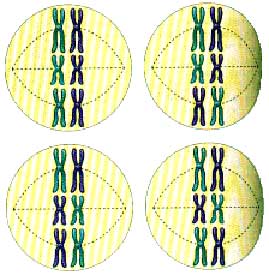Meiosis
Meiosis is a type of cell division which reduces
the normal chromosome number to one half.
Haploid gametes are made. Meiosis is considered a reduction
division, in that the number of chromosomes in the resulting cells each
has half the normal diploid chromosome number.
Steps:
a. Replication (doubles chromosome #) Humans: 46
to 92.
b. 1st division (chromosome # returns to normal. The homologous chromosomes
separate.) Humans: 92 to 46.
c. 2nd division. Sister chromatids separate (Forms haploid cells of 1/2
chromosome #.). Humans: 46 to 23.
[Diagrams of the
Stages of Meiosis]
Homologous chromosome: one of a pair of similar
(size, shape, genes) chromosomes. Each pair of chromosomes contains the same
genes, arranged in the same sequence. However, because each member of the pair
has come from a different parent, they usually have different alleles of their
genes (Ex.: one chromosome has a blue-eyed allele from mom, the other of the
pair has a brown-eyed allele from dad, etc....).

Diploid: A cell that contains both chromosomes
of a homologous pair.
Haploid: A cell that has only one chromosome
of each homologous pair. The fusion of 2 haploid cells creates a diploid cell
(fertilized egg).
 -----
-----

Gamete: Sex cell. Haploid. Egg & sperm.
Nondisjunction: Mutation caused when a replicated
chromosome pair fails to separate during cell division, causing changes in chromosome
#. One gamete gets an extra chromosome, one gets one less! (Example: Down's
Syndrome, Trisomy X)
Mendel's Law of Segregation:
During formation of egg or sperm (meiosis), the 2 genes (alleles) for a trait
separate (each goes to separate eggs or sperm).
Meiosis results in essentially an infinite genetic variety in the sex cells,
partly by crossing over (where sister chromatids exchange chromosome pieces)
or by randomly lining up along the equator (See diagram below.).

The number of possible chromosome orientations is 2 raised to the power of
the number of chromosome pairs. In the cells shown above, their are 2 to the
3rd power (8) possibilities of which 4 are shown above. With human cells there
are 2 to the 23rd power possibilities, which is 8.4 million possible ways to
mix the 23 chromosome pairs!
Sexual Reproduction: Offspring have mixed DNA (1/2 from each parent) which creates new combinations of genes, allowing some offspring to potentially have a better chance of survival. Sex is an advantage for changing environments.
[Comparison of Mitosis and Meiosis]
Slichter


 -----
-----

